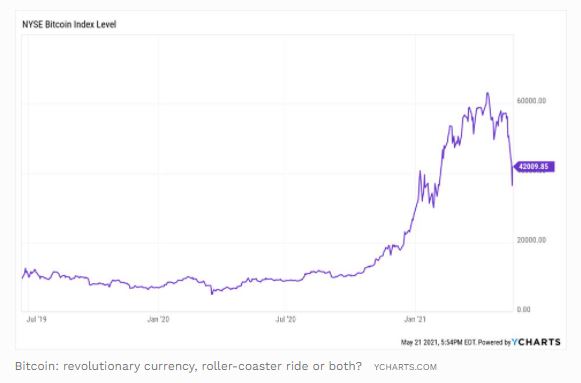Even if you don’t know what cryptocurrency is, it matters to your wealth
Bitcoin: heard of it? Since even octogenarians are asking their grandkids about it, I suspect you have. Cryptocurrencies, of which Bitcoin is the best-known, are taking over the imaginations of people everywhere. Note that I said people, not investors. Because after watching the roller-coaster ride that is Bitcoin for several years, hearing all the bull, bears (and pigs) on all sides of the debate, I can truly say the following about Bitcoin’s place in today’s financial markets: it is a benchmark for speculation and greed.
Now, that doesn’t mean that the blockchain technology that the crypto-sphere is based on is speculation and greed. It is very real, and over time, we may all be better off for it. But as the chart below shows, the price fluctuations in crypto are not something that can be correlated with the word “investment.” That volatility is not like a stock that beat or missed earnings expectations and sees its price flop around by 5-10% for a few days, as investors react.
Bitcoin is like a roller-coaster that doesn’t have an off switch.
How wild is the ride? The price fell 10% from the time I pulled this end-of-day chart from May 20, to the stock market close a day later.
How wild has the ride been? How’s this for a 9-month trip (figures rounded):
12,800 to 7,400 to 10,300 to 5,300. And with the stratospheric move to over 60,000 earlier this year, you can’t even see that 9-month period in the chart (it was from June, 2019 to March, 2020).

Bitcoin fell 40% within the current month of May, 2021. It drops like that a lot, and then it has historically recovered to new heights. And, based on the chart patterns shaping up, another epic plunge would not be a surprise. However, this is one little part of a gigantic financial system, right? So what if its price is all over the map. Actually, I think there is more to it than that.
Bitcoin and its Bit-cousins: taking the place of investment education?
When an asset gets that popular, then pulls back in price like that, the knee-jerk reaction is similar to tech stocks around this time in the year 2000. “Buy the dip, it will come back.” The real issue is that such a rallying cry is based on the so-called “recency effect,” where people think just assume what happened before will happen again. Often, it does...until it doesn’t. That’s when fortunes are lost. And, while we are focusing on Bitcoin here, I have come to realize that crypto becomes a stronger indicator of investor fear. And these days, fear is hard to find.
My concern, shared by others I follow in the media, is that crypto has gone from interesting alternative to gold, to monetary system replacement, to feeding frenzy for both investors and financial “opportunists.” It is not simply that there will be scams mixed in with legit business in this space. It is that many investors are being sucked in by the allure and excitement of this corner of the investment markets.
This creates a catch-22. For investment educator-types like me, the idea that so many people are now interested in investing is fantastic. However, it appears that they are skipping right past “Go” to collect their proverbial $200 by plunking down money in some thing that their friend’s kid said only goes up, blah blah blah. There’s a word for that: bubble. You can substitute “mania” if you prefer.
The market tells a story. We only need to listen.
None of this means I am anti-crypto or pro-crypto. My investment approach is more about seeing the story the market is telling us through price patterns, other data and investor sentiment. The story it is telling now involves an obsession with something that is controversial in part because one of the hot debates around it is whether it can be understood. Think about that: there are very smart investment folks who say that crypto is not something they can even explain to themselves, while others believe it is straightforward and revolutionary. That alone makes this bubbly, and thus hazardous to wealth.
The bottom-line is that the crypto-mania is not just about crypto. This type of investor behavior is the type of thing that tends to happen at the tail end of market cycles. It is sort of like the end of a college party, where students furiously look all over to find anything with alcohol in it, just to keep drinking and keep the party going.
So, do as you wish with Bitcoin. But understand that the price activity, the intense attention it garners and market history imply that this will end badly for many unsuspecting investors. When? Who knows? Just remember what you are investing for, and let that be your north star. That will help you put any potential investment in perspective.

